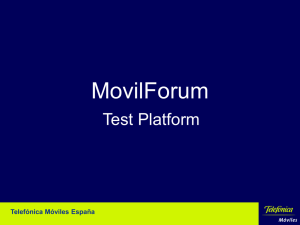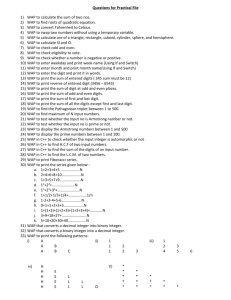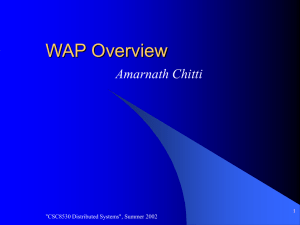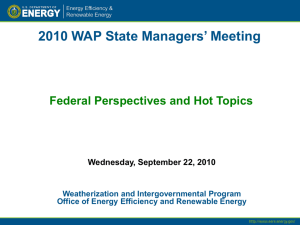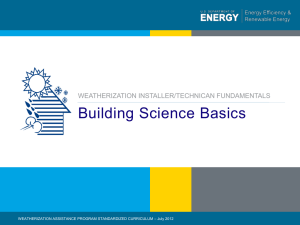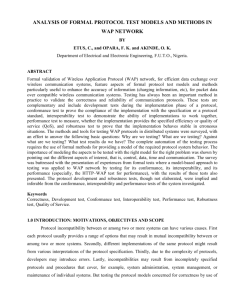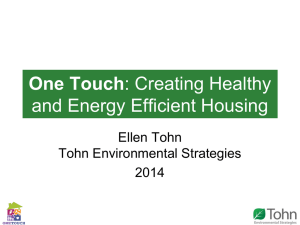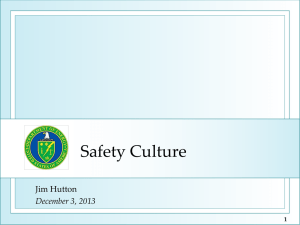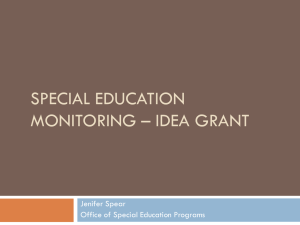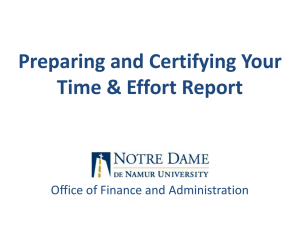The Future of Weatherization with Bob Scott
advertisement
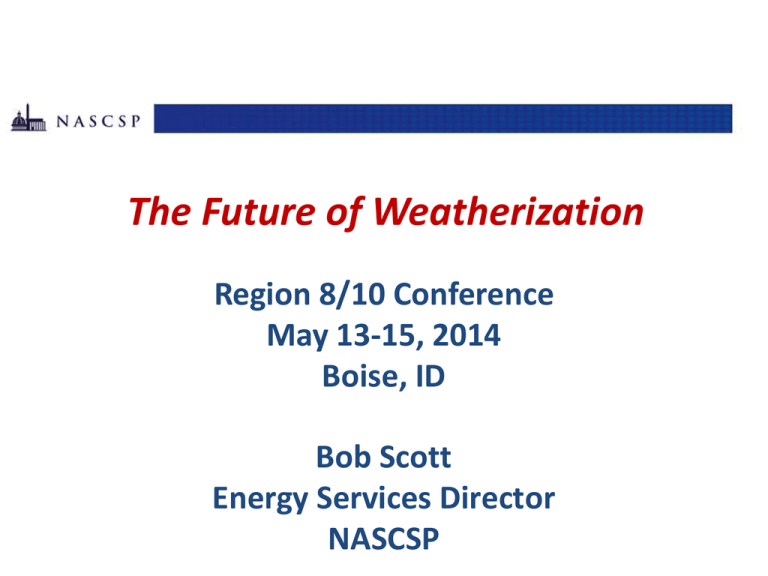
The Future of Weatherization Region 8/10 Conference May 13-15, 2014 Boise, ID Bob Scott Energy Services Director NASCSP What We Will Be Discussing • • • • • A little about WAP pre-ARRA How ARRA changed WAP Legislative Update WAP Advocacy DOE WAP Updates and Program Direction – Quality Work Plan – Quality Management Plan • Other as per Group Interest Weatherization Assistance Program (WAP) • Long time and sustaining operational structure for the residential energy efficiency • Has spurred home performance • Catalyst for the industry – Promoting building science – Developing diagnostic procedures and installation techniques – Raising awareness and protocols for health and safety – Largely created the market for supply chain businesses for the industry WAP Evolution From insulation, storm windows, outside caulk, etc. to: • Cost-effective measures as per energy audit • Highly trained workforce • Analyzing IAQ and health and safety • Quality tools and equipment • Best installation techniques WAP Evolution From To Pre-ARRA WAP • WAP - America’s Best Kept Secret • Bi-partisan support • Kind of low-profile, under the radar ARRA changed all that 7 What Happened during ARRA? • • • • Political target for President’s opposition Slow start Negative Press IG reports What Happened during ARRA? Resounding success by these measures • Weatherized more that 800,000 homes • 150,000 + > projected • Maintained about 15,000 ARRA jobs • Typically 7th or 8th on list of projects Deadlocked? What’s Happened Since ARRA? • 2012 - $68 Million – <30% pre-ARRA – Perception (Reality) of unspent funds available to network • 2013 - $139 Million – CR of $68 M – sequestration – DOE supplemented WAP by > $70M • 2014 - $174.3 Million – Good level under the circumstances but – Still below pre-ARRA What is the Outlook for FY 2015? Optimistic because – • Presidents budget was $227 M • Senate support letter @ $230 M • House support letter @ $227 M Not so optimistic because – • FY 2014 budget deal was a two-year agreement • November mid-year elections • Still a lot of gridlock What is the Outlook Beyond FY 2015? Optimistic because – • The trend is in the right direction • The ARRA hangover is wearing off Not so optimistic because – • Congress is still not in a spending mood • Hard to predict sentiment of the country as 2016 elections approach Can We Influence WAP Funding Levels? A few things about how Congress works and The role of local advocacy What is “Regular Order” • Regular Appropriations bills with twelve appropriations subcommittees – should be reported from Committee by late spring • Omnibus Appropriations bills • Continuing Resolutions • Supplemental Appropriations Annual Appropriations Cycle • • • • • • • • President submits budget first Monday in February Congress adopts Budget Resolution in April Timetable for Appropriations bills House & Senate Committee markups in May/June House & Senate floor action should occur in summer House & Senate Conference Action Presidential Action All bills are supposed to be enacted before 9/30, which is the end of the federal fiscal year 7 Guidelines to Effective Advocacy 1 7 1. 2. 3. 4. Do your homework “All Politics Is Local” (Tip O’Neill) Grass roots advocacy is best Speak for no more than 3-4 minutes at the most; keep your arguments brief 5. Don’t be surprised if you get a negative response or lack of interest; keep trying & be appreciative of time 6. Be clear about your “ask” 7. Above all: make your “why” clear Bi-Partisan Approach is Key • WAP’s poor funding years have always been when the program became politicized • By its nature, WAP can appeal to both sides of the aisle • Job creation, adding new tax revenue, and role of private business resonate well these days Effective Advocacy Approaches • • • • Letters were the standard but … Office visits Emails and phone calls Social media, particularly Twitter – Real Time Advocacy • WAP events Effective Advocacy Approaches Another key is to be ready to act • Idaho CAP advocacy in December 2013 was critical in WAP funding increase! WAP Public Information Campaign • Major section on WAPTAC • Manuals – – Weatherization Day Planning Kit – Site Demonstration Planning Kit – Social Media Guide – WAP Story Telling Guide WAP Site Demonstrations Great way to showcase WAP • Needs careful planning • One key is targeting critical attendees WAP Site Demonstrations I’ve heard many times – “I had no idea you did all this” and “How can I get this done on my house?” Real Time Advocacy - Twitter 24 Programmatic Changes in WAP Web-Based Weatherization Assistant • • • • Multifamily Tool for Energy Audits (MulTEA) Health and Safety Audit Tool National Energy Audit Tool (NEAT) – Single-family Manufactured Home Energy Audit (MHEA) Programmatic Changes in WAP Increased Emphasis on Multi-Family • Standard Work Specifications for Multifamily Energy Upgrades • Multifamily Job Task Analyses (JTA) Coming Soon! • Multifamily Tool for Energy Audits (MulTEA) • Technical Guidelines for Multifamily Building Energy Audits – The Technical Guidelines tell the energy auditor what the datagathering and energy-auditing process should entail. – The guidelines facilitate uniformity in multifamily energy audit methods, to lead to more accurate predictions of energy and cost savings. Programmatic Changes in WAP DOE Quality Work Plan • Based on Guidelines for Home Energy Professionals initiative • Intent to demonstrate quality and accountability of WAP • Help ensure long term sustainability of WAP as a leader and foundation of the home performance industry DOE Quality Work Plan Core Components • Revised / updated Field Standards and Field Guides based on the Standard Work Specifications • Training Program accreditation • Home Energy Professional certifications DOE Quality Work Plan Field Standards and Field Guides • WAP measures must meet minimum outcomes and specifications outlined in SWS • WAP Grantees must update / revise their documents and make them available DOE Quality Work Plan Quality Control Inspections • 100% of homes are inspected to comply with SWS • Homes must be inspected by a certified QCI – New testing protocols – not the more conventional BPI certifications DOE Quality Work Plan Training Requirements • Grantee Training Plans must include comprehensive training for all WAP workers that is aligned with the NREL Job Task Analysis (JTA) for the position in which the worker is employed. • Training Plans must address two distinct categories: – Tier 1 Training: Comprehensive, occupation-specific training which follows a curriculum aligned with the JTA for that occupation. Tier 1 training must be administered by, or in collaboration with, a training program that is accredited by IREC for the JTA being taught. – Tier 2 Training: Single issue, short-term, training to address acute deficiencies in the field including dense packing, crawlspace, ASHRAE, etc. Conference trainings are included in this category. DOE Quality Work Plan State Implementation Issues • Aggressive plan and timeline - many changes quickly • More information, tools, resources becoming available • Some debate on applying DOE QWP requirements to other funding sources weatherization programs • Affordability and cash flow DOE Quality Management Plan • Discussed at the 2013 Denver Meeting • Again moving via QMP Working Group • Key Components – – Core Competencies for Common Job Classifications • Grantee • Subgrantee – Recordkeeping and Reporting Consistency Core Competencies • Developed by Trainers Consortium in 2007 – Did more on technical positions – WAPTAC – Training Resources \ Training Tools • Working Group is focusing on management positions Core Competencies Key Definitions • Competency -minimum level of knowledge and proficiency required to collect appropriate information, make informed decisions, and physically take the needed actions to deliver the high-quality weatherization service in question. • Possess a working knowledge - Know how a particular topic impacts the weatherization process; Have the relevant information committed to memory or be able to locate it in readily available sources; and Use the knowledge to make informed decisions and guide weatherization work. • Demonstrate the ability to - Physically conduct a test, procedure, or technique on an actual house, a prop, or in a training lab in the presence of someone qualified to assess the particular competency. Core Competencies Example (2007) Program Manager Possess a working knowledge of: • Enabling legislation governing the U.S. Department of Energy’s (DOE’s) Weatherization Assistance Program; • DOE program regulations 10 C.F.R. 440; • DOE program guidance and policy issued via Weatherization Program Notice or memoranda; • Federal, state, and local budget process; • Federal financial assistance regulations 10 C.F.R. 600 and relevant OMB circulars; • Applicable state procurement regulations; • State and local approaches to monitoring, training, and technical assistance; • Applicable computer databases and tracking systems and the importance that they remain up-to-date, are secured and backed-up, and are used effectively to manage the program; and • Building science principles. Core Competencies Example (2007) Program Manager – Local Weatherization Coordinator Demonstrate the ability to: • Effectively communicate and manage weatherization staff and subcontractors; • Prepare and track a budget for implementing a local weatherization program; • Maintain a purchase order system to track contracted services and materials and tool requisitions; • Maintain a coding system to assure expenditures are charged to the correct budget category; • Maintain inventory tracking system for materials, tools, and equipment; • Submit accurate financial and production reports in a timely manner; • Comply with federal limits on administrative expenses; • Manage a small construction/production-focused operation; • Ensure rigorous, unbiased, and accurate final inspection of all completed units; • Provide adequate technical training for auditors, technicians, and inspectors directly employed by the local agency, and ensure that subcontractors receive appropriate technical training; • Ensure that weatherization work complies with state technical program standards; • Coordinate resources; and • Develop and implement innovative leveraging strategies. Quality Management Plan Recordkeeping and Reporting Consistency • List of required documents for every client file • Clear documentation of location of items and how it is accessed– in paper file, electronically filed Quality Management Plan • Still no timetable – Denver draft obviously not happening • Operators seem less apprehensive than QWP • Some real benefits Some Other Issues • Change in Cost per Unit to $6500 – Needed but results in fewer units • Better quality buildings since 1990 evaluation – Reduced savings potential • DOE focus on energy savings • Prioritize high users – what about others? • An aging network (with some new rising young stars) DOE Focus on Energy Savings No one disagrees except: • Still a lot of work related to Health and Safety and substandard housing issues • Some dialogue about only weatherizing best candidates in terms of energy savings The delivery network is basically a social services organization network What’s It All Mean and Where Are We Going? • WAP is continuing to evolve and raise the bar to a more standardized approach • Funding levels need to get back to at least pre-ARRA levels • Doubtful DOE funds will ever be sufficient to meet the need • WAP operators need to find additional resources and develop additional partnerships to weatherize more homes and do more on the homes Additional WAP Resources • • • • • LIHEAP funds Utility funds Fee for service Multifamily Weatherization Plus Health – Affordable Care Act opportunities • Other?

